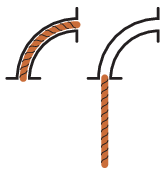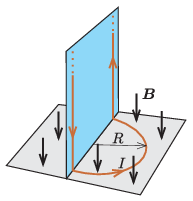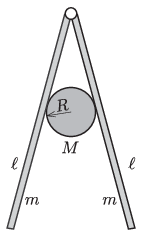KöMaL Problems in Physics, September 2023
Please read the rules of the competition.
Show/hide problems of signs:
 |
Problems with sign 'M'Deadline expired on October 16, 2023. |
M. 424. Measure how the distance covered by a pull-back toy car depends on the length of the backward pull.
(6 pont)
 |
Problems with sign 'G'Deadline expired on October 16, 2023. |
G. 821. On a clear, starlit night, you may notice that the stars ``twinkle'', i.e. their brightness changes. They even change their colour. The planets visible to the naked eye, on the other hand, do not squint or change colour. Explain this phenomenon. Do stars squint more at the top or the bottom of the sky?
(3 pont)
solution (in Hungarian), statistics
G. 822. How much distance does a train travel if it stands a total of 1 hour at train stops, it travels at a speed of 50 km/h between stops, and has an average speed of 40 km/h for the whole journey?
(3 pont)
solution (in Hungarian), statistics
G. 823. The arms of a two-armed balance have different lengths. If you put a cantaloupe in one of the pans, you can balance it with a weight of mass 960 grams. If you put the cantaloupe in the other pan, you can balance it with a weight of mass 1.5 kilograms. What is the mass of the cantaloupe?
(4 pont)
solution (in Hungarian), statistics
G. 824. A snake of length \(\displaystyle \ell\) slithered half of its length into a narrow, straight tube. The outside end of the snake can curve arbitrarily on the horizontal ground. At which points in the plane can the snake's centre of mass be located, if the snake is modelled by a flexible rope of length \(\displaystyle \ell\) with a uniform mass distribution?

(4 pont)
 |
Problems with sign 'P'Deadline expired on October 16, 2023. |
P. 5499. Martin slid down a slope on his sled in fresh snow. Shortly after his start, four pieces of candy cane fell out of his pocket (from a negligible height) onto the snow. During the slide, using his mobile phone Martin measured the acceleration of the sled as \(\displaystyle 2.1~\mathrm{m/s}^2\) and the angle of inclination of the slope as \(\displaystyle 23^\circ\). Later, he also determined the distances between the candies, which was 2 m between the first two, 3.2 m between the second and the third; and 4.4 m between the third and fourth candy.
\(\displaystyle a)\) Determine the coefficient of kinetic friction between the snow and the sled.
\(\displaystyle b)\) Prove that the candies fell out from Martin's pocket at equal time intervals.
(4 pont)
solution (in Hungarian), statistics
P. 5500. The long ropes of a swing can safely hold a maximum load of \(\displaystyle M\), when the swing is at rest. What is the maximum mass of a person that can swing on it, if the maximum angular displacement of the rope is an acute angle with a measure of \(\displaystyle \alpha\)? Plot your result on a graph!
(4 pont)
solution (in Hungarian), statistics
P. 5501. A rope is placed in a fixed tube which has a shape of a quarter of a circle as shown in the figure. What is the speed at which the rope leaves the tube if it is released? (Friction between the tube and the rope is negligible.)

(4 pont)
solution (in Hungarian), statistics
P. 5502. During the rescue of the cargo from a cargo ship that had sunk in the water, by means of a ship crane, a granite sculpture pedestal was lifted from a depth of 4 m, at a constant speed of 0.2 m/s. The pedestal is a solid square based rectangular block made of granite of density \(\displaystyle 2750~\mathrm{kg/m}^3\), its height is 2 m and its base edge is 1.5 m. Initially the pedestal rests on its square base at the bottom of the riverbed. The granite block is raised until its bottom base is raised 3 m above the surface of the water. During lifting, the longer edges of the pedestal continuously remain in vertical position.
\(\displaystyle a)\) How much work must be done during the whole lifting process?
\(\displaystyle b)\) How did the power of the crane change during the lifting process?

(4 pont)
solution (in Hungarian), statistics
P. 5503. A vessel of volume \(\displaystyle V = 80~\mathrm{dm}^3\) contains a sample of gas of mass \(\displaystyle m = 191\) g and of heat capacity \(\displaystyle C_V = 124.5\) J/K, at a temperature of \(\displaystyle T = 402\;{}^\circ\)C, and at a pressure of \(\displaystyle p = 4.2\cdot 10^5\) Pa. What is the degree of freedom of the particles of the gas? How many gas particles are in the vessel? What kind of gas can be in the vessel?
(4 pont)
solution (in Hungarian), statistics
P. 5504. A current of value \(\displaystyle I\) flows in a semicircle-shaped wire in the horizontal plane. The radius of the semicircle is \(\displaystyle R\). There are long vertical wires attached to the endpoints of the semicircular wire, through which the current is led into the semicircle. The whole arrangement is placed into uniform vertical magnetic field of induction \(\displaystyle \boldsymbol B\). What is the magnitude and direction of the magnetic force acting on the ensemble of wires?

(4 pont)
solution (in Hungarian), statistics
P. 5505. A room is illuminated by a five-arm chandelier, attached to the ceiling. A symmetrical double convex handheld magnifying glass lies on the desk in the room. A glance at the magnifying glass reveals two images of the chandelier at different magnifications and orientations.
\(\displaystyle a)\) How are the two images created?
\(\displaystyle b)\) Into which directions do the arms of the chandelier point in reality?

(5 pont)
solution (in Hungarian), statistics
P. 5506. Consider the electron as a small, uniform-density, and uniformly charged sphere such that its energy calculated from the mass-energy equivalence equation is equal to the energy of the electrostatic field around the electron.
\(\displaystyle a)\) Determine the radius of the electron, which is called the classical radius of the electron.
\(\displaystyle b)\) The electron is a particle with half-integer spin, because its intrinsic angular momentum is half of the reduced Planck constant \(\displaystyle h/2\pi\), that is, \(\displaystyle \hbar/2\). Let us consider the electron's intrinsic angular momentum according to classical Newtonian mechanics, as the angular momentum of a uniform solid sphere rotating about an axis passing through its centre. Determine the tangential speed of a point on the ``equator'' of the rotating classical electron. Compare this with the speed of light.
(4 pont)
solution (in Hungarian), statistics
P. 5507. Two identical rough boards are attached to a horizontal fixed axle. Friction between the boards and the axle is negligible. Both boards have a mass \(\displaystyle m\) and a length \(\displaystyle \ell\).
A cylinder of mass \(\displaystyle M=\frac 12m\) and radius \(\displaystyle R=\frac 15\ell\) is placed between the boards.
\(\displaystyle a)\) What must the least value of the coefficient of static friction between the planks and the cylinder be so that the cylinder can remain in equilibrium somewhere (at a suitably chosen point)?
\(\displaystyle b)\) What can the angle subtended by the boards be when the cylinder is in equilibrium?

(6 pont)
Upload your solutions above.
